
Downtown Malmö. If Nigel Farage, Donald Trump and Katie Hopkins are to be believed, this city is an interracial war zone
In the third and final part of a series of posts about modern Sweden (parts one and two can be read here and here), I look at immigration, and the crime problems that many neo-cons claim it has caused. The reality is very different. Angst about rising crime, in what remains one of the safest countries in Europe, is but one of many Swedish paradoxes.
Amidst many differences between Britain and Sweden, one area of similarity stands out: both countries are fixated on migration. The nationalistic, Eurosceptic and anti-migration Swedish Democrats show no sign of peaking as UKIP have in Britain, and are expected to make big gains in the September 2018 national and regional elections. The latest opinion polls put the Swedish Democrats’ support at almost 25%, second only to the governing Social Democrats and ahead of the traditional centre-right Moderate Party. A few polls have even put them in first place, ahead of the Social Democrats.
A decade ago this would have been unthinkable. The Swedish Democrats were founded in 1988 but spent more than 20 years in the far-right wilderness, not winning any seats in the Riksdag – the Swedish parliament – until 2010.
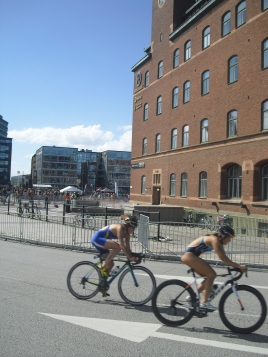
A cycle race in Malmö
Although there has always been a far-right presence in its politics, until recently Sweden was seen as a model of moderation, tolerance and integration. In 2006 a first-generation immigrant from Burundi, Nyamko Ana Sabuni, was even appointed as minister for integration and gender equality by Sweden’s centre-right prime minister Fredrik Reinfeldt; no British cabinet has ever featured anyone like her. But Sweden’s current social democrat Prime Minister, Stefan Löfven, has recently had to water down his warm welcome to migrants, adopting a more lakom approach (welcoming enough migrants to maintain Sweden’s reputation as a liberal beacon abroad, but not too many to provoke a political backlash at home).
There’s much angst about racial tensions in and around the southern city of Malmö (with a population of 340,000, Sweden’s third-biggest) in particular. And there certainly is a genuine violent crime problem. A few months ago, police stations in Rosengard (a troubled area of Malmö) and Helsingborg (a picturesque town 60km north of Malmö and just across the Øresund from Hamlet’s castle of Elsinore) had explosive devices hurled at them. Explosives are often used by organized crime rings, especially in the southernmost region of Skåne, where settling of scores and intimidation are frequent among drug traffickers.
In the meantime neo-con politicians and journalists take great pleasure in reporting how Sweden’s “immigration experiment” is entirely to blame for these crimes. Ludicrously, Nigel Farage has described Malmö as the “rape capital of Europe”, while Donald Trump has referred to immigration leading to “problems like they [the Swedes] never thought possible.” In March 2017 Katie Hopkins wrote a controversial story about Swedish crime (headlined, in typical Daily Mail fashion, “Where females fear to tread: Katie Hopkins reports from Sweden, the Scandi-lib paradise where terrified women have vanished from the streets and a conspiracy of silence and self-censorship on immigration buries the truth”) which only poured fuel on the fire.

The Clockwork Orange interior of the cafe at Malmö’s contemporary art gallery, the Moderna Museet
Even by her own abysmally low standards, Hopkins’ piece was muck-racking, self-fulfilling journalism of the worst possible kind. Hopkins went to the Stockholm suburb of Rinkeby and found that women were afraid to go out alone at night (sadly a pretty universal situation in any large European city, and nothing to do with migration), and that police had found an unexploded hand grenade in a bin. Her conclusion – that “what used to be seen as the most liberal country on earth…. was ready and waiting to blow” was made even less plausible by the revelation that one of the people who had shown Hopkins around this multicultural hellhole was a holocaust denier called Peter Sweden (Hopkins posed for a photo with him, later deleted from her Twitter account).
A slightly more measured story by Bojan Pancevski for the Sunday Times in January 2018 (‘Teens roam streets with rifles as crime swamps Sweden’) quoted the Swedish writer Paulina Neuding – descended from Jewish immigrants from Poland – as saying that Sweden is experiencing a “sexual assault crisis”.
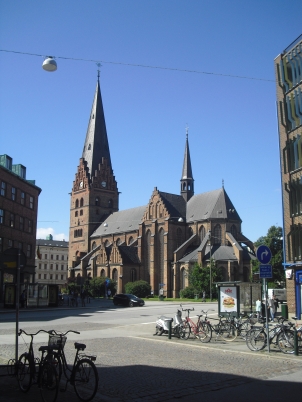
Dominated by its Lutheran cathedral, Malmö shows little sign of the rampant islamisation alleged by the neocons
The truth is of course a lot more nuanced. In fact rape levels have fallen in recent years. Sweden may have the highest rape level of any EU country. But Swedish law defines anyone paying for sex with a prostitute as a rapist, so international comparisons of raw data are of little use. Crime surveys reveal that rape levels are no higher in Sweden than in similar countries like Denmark or the Netherlands. And although many violent crime rates have increased in the last couple of years, the murder rate in Sweden remains below the EU average and less than a third of American rate. Even in Malmö, scene of a shocking triple murder earlier this summer, the long-term crime trend is still down.
According to Thomas Hylland Eriksson, a Norwegian academic, it’s difficult for Muslims to integrate with young people who “drink a lot of beer, and then eat dead pigs, and then… go home and have sex with strangers”. But in fact Brexit Britain should not fear what is happening in Sweden, but learn from it: compulsory Swedish lessons for migrants, properly-resourced enforcement action to stamp out black-market labour, and identity cards mean there is more integration, less casual racism, and less abuse of the system than in the UK.
My partner Liz has spent the past year teaching dozens of first-generation middle-eastern migrants at an English-language school in Skåne. The vast majority of these students, in Sweden just as in the UK, were children who had gone through great upheaval but who nevertheless wanted to work hard, integrate and become a valued member of western society.
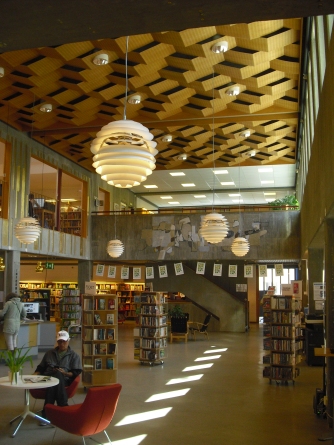
The Bibilotek in Kristianstad. Even small-town libraries have a grandeur and presence rarely found in British municipal buildings
Indeed, given the recent history of racist attacks in Malmö you could almost congratulate its Muslim youths for their restraint. Between the 1970s and 1980s, deindustrialisation meant the population of Malmö fell by a whopping 40,000 (almost 10%; in Rosengard the decline was even steeper, at 40%). As with similar British cities like Liverpool, immigration has been one of the reasons that Malmö has been revitalised, not the reason for its decline. But Malmö’s new communities have been under relentless attack ever since they arrived. Between 2005 and 2015, the mainstream mosque in Malmö was subject to several arson attacks, and in 2009-10 there were 15 handgun shootings in and around the city, thought to be largely the work of a racist sniper called Peter Mangs. And across Sweden, many of the most shocking crimes of the last 30 years have been carried out by Swedes against immigrants, not the other way around. In 1991 eleven black and Asian people were shot, one of them fatally, by a racist sniper in Stockholm and Uppsala. In 1998 63 revellers died in a discotheque fire in Gothenburg started by four teenagers who had been denied entry, but the calamity caused only a small ripple as most of the victims were immigrants.
And contrary to what many commentators assert, immigration is nothing new here. By 2008 1 million people – out of a total population of more than 9 million – were already foreign-born. Sweden received a huge influx of immigrants from Chile (many of them dissidents fleeing Pinochet), Yugoslavia and Finland in the 1970s, until the unions started to complain about too much cheap immigrant labour.
In fact, the vibrancy of Malmö refutes the picture that Katie Hopkins painted when she flew in here for just a few days in 2016. Malmö is often spoken of by locals as a “dangerous place”, as if it’s on a par with the Bronx of the 1980s. But I’ve wandered around its squares, and its fantastically-restored railway station, late at night and felt safer than I would in any similar-sized-British city. Bojan Pancevski wrote earlier this year that in Malmö’s historic centre “there is little sign of the crime epidemic”, and he’s right.
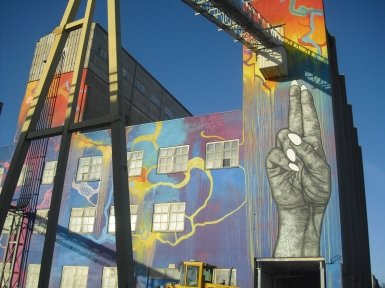
In Bromölla the Ifö plant – one of Sweden’s largest toilet and sanitaryware factories – has a mural that wouldn’t look amiss on a 1970s concept album cover. An architectural paradox unthinkable in Britain.
The hyperbole about rising crime, in a country that is in reality one of the safest in Europe, is just one of many Swedish paradoxes. Strangers rarely talk to each other, but there are few privet hedges in Swedish suburbs, and everyone’s salary can be researched online (this transparency predates the internet: in the late 1960s Susan Sontag was amazed to discover that the Swedish government published a list of all those earning more than 20,000 SEK a year). Although Sweden is regarded as being well ahead of Britain in terms of women’s rights, homosexuality was officially classified as a mental disorder until 1979. Despite the excellent childcare and family-friendliness, Swedes have for a long time married later than most other Europeans, had fewer children and been more likely to divorce and remarry (by one measure Sweden has the third-highest divorce rate in western Europe, after Denmark and Finland). The benevolent Swedish welfare state is at once collective and individualistic: people are helped as individuals, not as family units as in Germany. Joint bank accounts for spouses are almost unheard of in Sweden, yet every café and restaurant will offer communal blankets to those sitting outside.
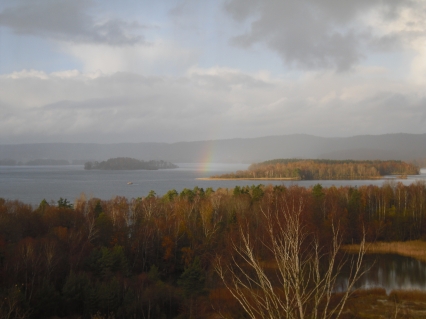
Even the relatively flat southern region of Skåne is full of island-studded lakes, rolling forests and dramatic vistas
While drinking and eating out can be prohibitively expensive, the state hands out goods without even being asked. Earlier this summer my daughter was sent a travel pass giving her unlimited free travel on public transport in Skåne, throughout July and the first half of August; an adult can buy a similar pass for just £55. Such deals would be unthinkable in Britain, a supposedly cheaper country.
For an underpopulated country with huge tracts of wilderness, the Swedes have a lot of affection for their home comforts. Pippi Longstocking, Sweden’s most famous 20th-century children’s character, is in many ways a self-sufficient Übermensch with supernatural powers and unrestricted access to her father’s crock of gold, but her story is told through the eyes of her conventional neighbours, Tommy and Annika, who depend on their protective parents for suburban creature comforts.

Signs for Skyddsrum – nuclear bomb shelters – are still a common sight on blocks of flats
Church and State were separated in Sweden back in 2000, though taxpayers still pay an annual levy to the church (you can opt out, but most people don’t see it as worth the hassle). Despite its longstanding neutrality Sweden still has a huge arms industry (Saab, the troubled Swedish car-maker, started life as a plane-maker). And for a state that has never been a member of Nato, Sweden still has a surprisingly strong Cold War mentality: in the cellars of just about every twentieth-century apartment block are Skyddsrum, nuclear bunkers with bomb-proof metal doors. In most of these cellars are individual chicken-wire hutches for household storage, entailing a collectivism and a lack of privacy that few Britons would tolerate.
A civil defence leaflet entitled Om krisen eller kriget kommer (If crisis or war comes), informing residents what to do in the event of foreign invasion, was recently delivered to every Swedish household; something that would be derided in Britain back in the 1980s and would be ridiculed even more so today. But in calm, collected Sweden such nanny-statism is accepted without complaint.
I began the first part of this series of posts with Susan Sontag’s 1969 diatribe against Sweden, a country she could not wait to get out of. Did she stay away from Sweden for the rest of her life as she had vowed? No, two years after her diatribe she was back to make another film. I think I’ll be back soon as well.
All photographs by Alex Grant

Pingback: Sweden, a land where consumer has never been king | Alex Grant
Well done Alex – a really interesting short series. More cathedral cities now you’re back ?